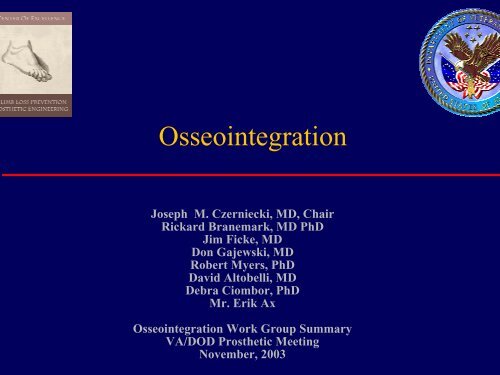Osseointegration - Rehabilitation Research & Development Service
Osseointegration - Rehabilitation Research & Development Service
Osseointegration - Rehabilitation Research & Development Service
You also want an ePaper? Increase the reach of your titles
YUMPU automatically turns print PDFs into web optimized ePapers that Google loves.
<strong>Osseointegration</strong><br />
Joseph M. Czerniecki, MD, Chair<br />
Rickard Branemark, MD PhD<br />
Jim Ficke, MD<br />
Don Gajewski, MD<br />
Robert Myers, PhD<br />
David Altobelli, MD<br />
Debra Ciombor, PhD<br />
Mr. Erik Ax<br />
<strong>Osseointegration</strong> Work Group Summary<br />
VA/DOD Prosthetic Meeting<br />
November, 2003
Statement of Problem<br />
• Residual limb comfort and the prevention of skin injury<br />
are the two most important issues that amputees<br />
experience.<br />
• Current socket designs and interface materials although<br />
an improvement over those of the past continue to be<br />
limited.<br />
• From an administrative perspective the resolution of<br />
these needs must be balanced by the multiple domains of<br />
need the amputee experiences, including psychological,<br />
novel prosthetic components, pain management, limb<br />
salvage and prevention of secondary disability.
Aspects of <strong>Osseointegration</strong> Considered<br />
• Immediate Clinical use of osseointegration in<br />
VA/DOD<br />
• Pilot Clinical <strong>Research</strong> Procedure<br />
• Basic Science <strong>Research</strong>
Clinical <strong>Osseointegration</strong><br />
• Not Recommended<br />
– Primary amputation procedure (revisions only)<br />
– Need for further research<br />
• Better Outcome Data<br />
• Safety<br />
• Efficacy<br />
• Cost Effectiveness
Pilot Clinical <strong>Research</strong> Study<br />
The primary population would be Transfemoral Amputees<br />
- greatest experience<br />
Secondary populations would likely be Transhumeral,<br />
Thumb
Pilot Clinical <strong>Research</strong> Study<br />
First Step<br />
Implement a Survey of VA/DoD Transfemoral Amputees<br />
–Survey of potentially eligible VA/DOD population.<br />
•Define the scope of the problem<br />
•Define the potential population who might benefit<br />
•Necessary background data to obtain an<br />
FDA Investigational Device Exemption (IDE)
Survey Population<br />
• It has been used as a secondary procedure for those who have been a<br />
“failure” of conventional treatment.<br />
• Veterans with traumatic injury Vietnam, ?Korea.<br />
• Retired military with traumatic injury.<br />
• Few who MVA, motorcycle other trauma while in the service.
Survey Content<br />
• Prosthesis Use<br />
– Time, frequency, duration<br />
– Prosthesis Satisfaction (PEQ?)<br />
– Ease of donning doffing<br />
• Mobility (Stanmore Mobility Scale)<br />
• Quality of Life Measure
Pilot Clinical Study<br />
• Structure<br />
• Population<br />
• <strong>Research</strong> Design<br />
• Outcome Measures
Structure<br />
• Establish a limited number of Clinical<br />
<strong>Osseointegration</strong> Centers<br />
– ? East Coast, West Coast<br />
• Training<br />
• Team (PT, Prosthetist, Rehab, Surgeon) go to Goteburg to<br />
develop the skills and necessary program.<br />
• Dr. Branemark comes to US once subjects are identified to<br />
provide direct training of surgeon.
Population<br />
• Transfemoral Amputees<br />
• Not done as a primary procedure but for those who are<br />
“failures” of conventional treatment.<br />
– Questionaire<br />
– Prosthetic Evaluation<br />
– Team clinical Evaluation<br />
• This would indicate possible candidate.
Population<br />
• Exclusionary Criteria<br />
– Poor bone density<br />
– Abnormal skeletal anatomy<br />
– Psychiatric diagnosis<br />
– Surgical Medical -----Excess surgical morbidity<br />
mortality<br />
– History of non-compliance with treatment program<br />
– Diabetes, PVD, Immuno-incompetence
Study Design<br />
• Measure the effect in subject population before<br />
treatment/during treatment/after treatment.<br />
• Control group with intensive prosthetic fitting and<br />
provision of optimum components, with physical<br />
therapy for gait training strengthening,<br />
conditioning, ROM.
Outcome Measures<br />
• Pain (Numerical pain rating scale)<br />
• Pain (functional social impact of)<br />
• SF-36<br />
• Quality of Life<br />
• Stanmore mobility scale<br />
• Gait Analysis/VO2<br />
• Step Activity<br />
• Balance (Kenton Kaufman)<br />
• Cost/Benefit Analysis<br />
• Body Image/Social Role Functioning
Basic Science <strong>Research</strong><br />
Establish an <strong>Osseointegration</strong> Basic Science Center of Excellen<br />
• Bone/Implant Interface<br />
– Goal- Accelerate the time<br />
frame of osseointegration to<br />
reduce the time interval of<br />
the intervention.<br />
– Accelerate the rate of bone<br />
adaptation.<br />
– Strut mechanism to<br />
accelerate loading.<br />
– Needs for accurate<br />
evaluation of integration and<br />
bone adaptation.<br />
• Skin/Implant Interface<br />
– Lack of consensus whether this<br />
is a problem.<br />
– Goal - develop a new tissue<br />
engineering approach to<br />
eliminate the potential for<br />
ingress of bacteria.
Bone/Implant Interface<br />
• Accelerate the rate of osseointegration and<br />
bone adaptation.<br />
– Pharmacologic<br />
• BMP Bone morphogenic protein<br />
• MMP matrix metallo-protein<br />
•Cytokines<br />
– Physical<br />
• US, Pulsed EM Fields, DC current, physical loading
Skin/Implant Interface<br />
• Difference of opinion<br />
– ?If sound integration no risk of osteomyelitis.<br />
– ? Tissue engineering to develop an interface<br />
where there is integration of the skin and the<br />
implant.
Summary<br />
• Persistent residual limb pain is a problem for lower extremity<br />
amputees.<br />
• Preliminary published results are limited.<br />
• These data suggest the potential for substantial benefit but not<br />
without risk.<br />
• The potential benefits suggest that further work should be done to<br />
evaluate its efficacy with established outcome measures.<br />
• Additional Basic Science research could expand its safety and<br />
make it a much more broadly used therapeutic tool.
















